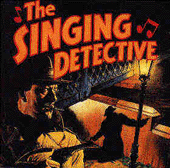
|
"Potterland is shaped like a dumb-bell, with the Forest
of Dean at one end, London at the other, and the railway connecting them.
London really means Hammersmith, for boyhood memories, and Paddington, where
trains from the West Country arrive to a neighborhood of whores, transients and
"rabs facing awa from Mecca." Trains and whores are Potter obsessions;
some of the others are dance music before the rock-and-roll era, Russian spies,
cowboys (and America, generally, as a mythic opposite of Britain),
the bombing of German cities by the R.A.F., cigarettes, betrayals, art deco
interiors, neurotic schoolteachers, the Oedipus complex, and everybody's
childhood."
|

























